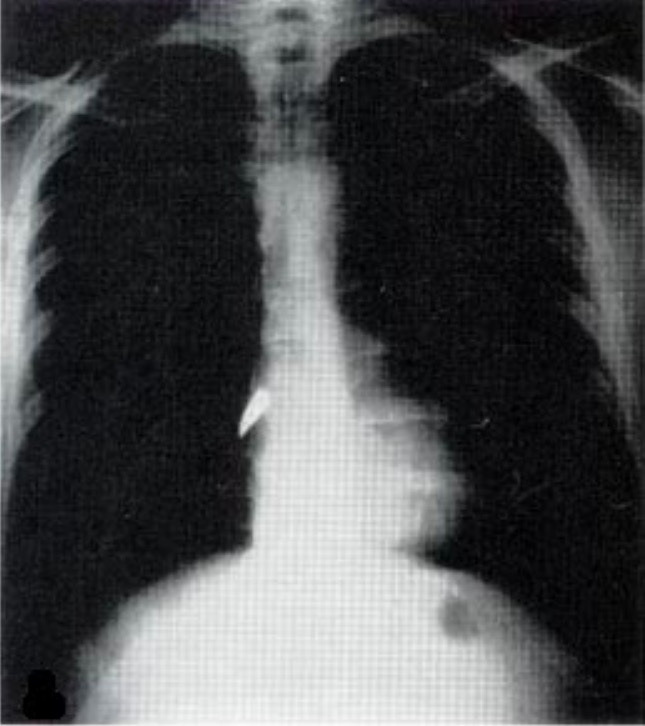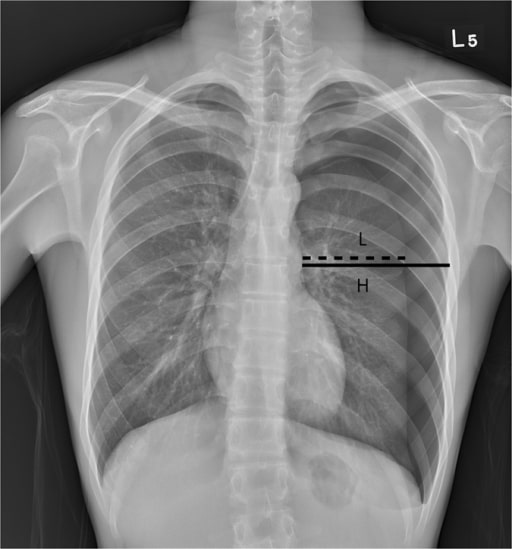Playlist
Show Playlist
Hide Playlist
Tension Pneumothorax: Needle Decompression & Other Treatments
-
Emergency Medicine Pulmonary Trauma.pdf
-
Download Lecture Overview
00:01 So what are we gonna do to treat a tension pneumothorax? Very simply, the first line of treatment is needle decompression and what we're doing when we decompress the lung is allowing air to get out of the pleural space. 00:15 So if I've got a big high pressure air collection here in my chest, the goal of decompressing is to make a conduit between the inside of my chest and the outside world that'll let that air escape. 00:29 And what's gonna happen, is that's gonna equilibrate the pressure inside of my pleural space with the atmospheric pressure. 00:36 However, it's not gonna make my pneumothorax go away, it's not gonna actually restore negative pleural pressure, I'm still gonna need a chest tube, but it's going to decompress the large air collection that is mechanically interfering with my cardiac function and my pulmonary function and it's gonna improve the clinical status of the patient very rapidly. 01:00 So I do wanna emphasize, it's a temporizing measure, it's not a definitive treatment. 01:05 What you're really doing when you decompress is you're taking a tension pneumothorax and you're converting it into a simple pneumothorax. 01:13 Needle decompression is also not indicated for simple pneumothoraces because it doesn't do anything for those patients. 01:19 We only use it for unstable patients with tension pneumothorax and the goal is to restore their normal perfusion and normal oxygenation while we go about providing them with definitive treatment. 01:34 So how do you do the procedure? It's actually a very simple and straight forward procedure and it's incredibly rewarding to perform because patients go from being an extremus, to being stable and comfortable and happy very, very quickly. 01:48 So if you get a chance to do this, I think you'll find it to be very satisfying. 01:53 The way it works is you take a 14 or 16 gauge angiocath or basically any large bore angiocath or needle and you're gonna insert it at the second intercostal space in the midclavicular line. 02:05 So you're gonna palpate both sides of the clavicle, you're gonna identify the midclavicular line, and then the second interspace is typically is about one centimeter below that, so that's what you're gonna aim for. 02:17 You also can use the fourth or fifth interspace in the anterior axillary line if that anatomy is more favorable for your patient, either one is acceptable. 02:27 So once you've inserted the needle, this is the really important part, you need to make sure that the needle is open to room air. 02:35 So you wanna insert the needle or angiocath in as far as it goes and then you wanna to take off your syringe, take off your needle lock, anything that might be obstructing the end of your catheter and you wanna let the pleural space communicate with the air in the room. 02:53 The goal again, is to let air go from the pleura out into the atmosphere In addition to needle decompression, there are other elements of treatment that you wanna perform. 03:04 Of course, you wanna give these patients supplemental oxygen to help decrease their respiratory distress and ensure that they're not hypoxic. 03:11 You want to avoid positive pressure ventilation until such time as you've addressed the tension pneumothorax. 03:18 'Cause as you can imagine, when we put a patient on positive pressure ventilation, we are actually pushing air down into their lungs and if they have an injury that's led to a tension pneumothorax, we're gonna be pushing air out through that injury into the pleural space and expanding the pneumothorax which is gonna make them worse. 03:37 So if your patient needs to be intubated, if they need to be mechanically ventilated, you should do that after you've already addressed your pneumothorax. 03:46 You also wanna place a chest tube once your patient is stabilized. 03:50 So you're gonna insert a large caliber chest tube on to the affected side and that's what's gonna restore your negative pleural pressure and allow the lung to heal. 04:00 This is necessary in order to allow the lung to fully reexpand and eventually allow it to seal off the defect that caused the tension pneumothorax in the first place. 04:11 So just a quick compare and contrast between tension and simple pneumothorax 'cause it's really important to be able to differentiate between them since the treatment is so different. 04:21 First and foremost, hypoxia. 04:24 Patients with tension pneumo often have severe hypoxia. 04:27 Whereas patients with simple pneumothorax, might be slightly hypoxic but typically it's not extreme. 04:35 Tension pneumothorax causes shock because of the physiology we've already described, whereas simple pneumothorax should never cause shock. 04:43 Simple pneumothorax does not impair cardiac function. 04:46 It does not impair venous return and it should have no hemodynamic consequences. 04:52 Breath sounds in tension pneumothorax are almost, always gonna be completely absent on the affected side. 04:58 Whereas in simple pneumothorax, you might have normal breath sounds, you might have reduced breath sounds. 05:04 If the pneumo is large, you may even have absent breath sounds but it's much more typical to be able to hear something. 05:10 Whereas in a tension pneumo, you can often hear nothing. 05:14 For tension pneumothorax, we temporized the patient with needle decompression. 05:18 So we're gonna go and stick a needle in the affected side to allow air to escape from the pleural space. 05:24 Whereas in simple pneumothorax, that procedure is not indicated and really only carries risk with no benefit, so we would never do it. 05:32 Patients with tension pneumo always need definitive treatment with a chest tube and patients with simple pneumothoraces often do as well. 05:39 It's quite common that we place chest tubes in those patients. 05:43 But for small pneumothoraces, sometimes, you can treat with just high flow oxygen, or in some cases, you can use pleural drains, pigtail catheters, etcetera, as opposed to a large caliber chest tube. 05:56 So you've got a few more treatment options available to you for simple pneumothorax. 06:00 With tension pneumo, you're always gonna go for a chest tube. 06:03 All right. 06:04 So the bottom line on tension pneumothorax is you should always suspect it in patients with chest trauma, who have unilaterally absent breath sounds, hypoxia, or severe respiratory distress, or shock. 06:16 Those are the things that should make you think about tension pneumo and when you're concerned about a tension pneumo, you wanna make the diagnosis clinically. 06:23 Once you've made the diagnosis, you're gonna perform a needle decompression in order to temporize the patient and then once they're stabilized, you're gonna place a chest tube which will serve as their definitive management.
About the Lecture
The lecture Tension Pneumothorax: Needle Decompression & Other Treatments by Julianna Jung, MD, FACEP is from the course Trauma (Emergency Medicine).
Included Quiz Questions
What is the temporizing management of tension pneumothorax?
- Needle decompression
- Orotracheal intubation
- Positive pressure ventilation
- CPR
- Cricothyrotomy
When doing needle decompression, where along the mid-clavicular line should the needle be inserted?
- Second intercostal space
- Third intercostal space
- Fourth intercostal space
- Fifth intercostal space
- Sixth intercostal space
What is the definitive treatment for tension pneumothorax?
- Chest tube placement
- Pleural draining
- Oxygen supplementation
- Needle decompression
- Positive pressure ventilation
Which of the following statements regarding needle decompression is INCORRECT?
- It restores the negative pleural pressure.
- It allows air to escape from the pleural space.
- It equilibrates the pressure between the pleural space and the atmosphere.
- It is the primary management for tension pneumothorax.
- It is indicated in unstable patients with tension pneumothorax.
Customer reviews
5,0 of 5 stars
| 5 Stars |
|
1 |
| 4 Stars |
|
0 |
| 3 Stars |
|
0 |
| 2 Stars |
|
0 |
| 1 Star |
|
0 |
Hello Mam! It’s very nice lecture! Only thing is that need to update as 10th edition of ATLS.





